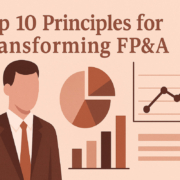3 Reasons Data-Driven Businesses Consistently Outperform
A while back, I pushed a forecast to the executive team that looked like it had been built in a sterile lab. Smooth trends. Tight margins. No funny business. It told the story we all wanted to hear: stable burn, healthy revenue growth, clean close into year-end.
It was the kind of model that says, “Relax. We’ve got this.”
Then came the board meeting.
And with the calm curiosity of a man picking apart a dead fish, one director asked,
“Why does gross margin tank in Q4?”
That was the moment I realized something was off.
Not slightly off. Not “we’ll adjust next cycle” off.
Off in a way that makes you wish you’d spent one more night crawling through that workbook.
Turns out, deep in the guts of the COGS forecast, we had a formula pointing to an old assumptions tab—pre-acquisition baseline, no updated headcount, no adjusted payroll logic.
Stale data. Outdated logic. A very believable lie.
Now, the model wasn’t fatally broken. But it was just broken enough to trigger what I call “spreadsheet side-eye”—the quiet erosion of trust.
And that’s the thing no one tells you: in finance, the currency isn’t accuracy. It’s confidence.
Once that’s gone, you don’t get a refund. You rebuild—slowly, painfully, and under scrutiny.
That moment taught me something I’ve carried through every role since—whether standing up a finance team post-acquisition or managing FP&A for $60M+ business units: Trust in your numbers isn’t given. It’s earned. Every single cycle.
And more importantly? It’s fragile.
Bad data doesn’t just break models. It breaks the business.
Most companies are one Excel link away from chaos.
I’m not exaggerating. You wouldn’t believe how many $100M revenue shops still run mission-critical forecasts on fragile, multi-tab monstrosities duct-taped together with VLOOKUPs and faith.
I’ve walked into subsidiaries post-acquisition where the “budget model” was a Frankenstein mix of half-manual inputs, year-old assumptions, and formulas that made sense only to the guy who left six months ago.
But here’s the punchline: no one wants to admit they don’t trust the numbers. So the lie lives on.
Until a mistake gets exposed.
And then?
It’s not just that forecast that gets tossed. It’s your credibility. Your seat at the strategy table.
You stop being the voice of clarity. You become the guy who missed the red flag in cell M43.
I’ve seen entire strategic shifts delayed because leadership stopped trusting the inputs. Not because they were wrong, but because they might be.
Data doesn’t have to be dirty to be dangerous. It just has to be uncertain.
Reviews catch math. Audits catch reality.
There’s a sick comfort in a model that ties. A clean workbook that opens without errors.
But tying isn’t trust. And working isn’t truth.
In one org I supported, we had just rolled out a new corporate structure across HR, Finance, and Ops. On paper, everything looked fine. Every division’s numbers reconciled. The P&L rolled up like it should.
But one analyst—an old-school accountant who never trusted any number she didn’t trace by hand—noticed a lag in labor cost allocation.
The source? A quarterly updated spreadsheet no one had touched since May.
It had been copied forward, assumptions intact, with zero reflection of the 20+ hires we’d added since.
Every leader who touched that model had reviewed it. But no one had audited the input.
And this is where it gets dangerous: the model looked great. The formatting was tight. The logic was solid. But the inputs were fiction.
That’s the trap.
Companies spend weeks fine-tuning the machine and seconds checking the fuel.
Then they wonder why the engine dies mid-flight.
If you’re not running input audits on the same cadence as your reporting cycle, you’re not modeling—you’re storytelling.
And you might be telling the wrong story.
Finance isn’t about math. It’s about behavior.
Let me be blunt: your job isn’t to make the numbers right.
It’s to make the business do the right things.
When I helped stand up finance teams post-acquisition, I saw the same mistake over and over again: treating FP&A like a spreadsheet shop instead of a behavioral design tool.
Finance isn’t a mirror. It’s a steering wheel.
If your comp plan rewards the wrong activity, you’ll bleed margin—quietly, over time.
If your reporting structure buries CAC behind blended averages, no one will see the churn until it’s too late.
During one integration, we rebuilt the entire comp structure for sales from scratch. Not because the numbers were off—but because the behavior was.
Finance has to ask harder questions:
Does this model incentivize the right deals?
Does this accrual reflect how the business actually operates?
Is this assumption still true, or just convenient?
The best companies don’t just use data to monitor performance. They use it to engineer it.
And that’s why they outperform.
Because they align their financial logic with human behavior.
Don’t let the formatting fool you.
The problem with modern finance? Everyone’s too impressed with their own formatting.
Nice fonts. Clean tabs. But underneath? It’s spaghetti logic held together with pivot tables and optimism.
I’ve seen forecasts that looked pristine right up until audit day—when suddenly the entire revenue projection collapsed because a junior analyst forgot to update one assumption from “manual override.”
Nobody noticed. Because it looked fine.
This is the corporate version of driving with the check engine light on and the radio up.
What separates elite finance teams from the rest isn’t their models—it’s their mindset.
They assume the model is wrong until proven right.
They verify sources, trace dependencies, and know exactly which assumptions will kill them if they’re off by 10%.
They don’t fear complexity—but they hate ambiguity.
That’s why they win.
Final thoughts
If you’re leading a finance team that’s grown faster than its systems—welcome to the club.
If you’re sitting on a model you don’t fully trust but still use every month—you’re not alone.
And if you’ve ever presented a forecast only to get blindsided by a question that exposes a flaw you should have seen—that’s the job. Own it.
But don’t let it define you.
Use it to tighten the screws.
Run audits. Clean your inputs. Tie your logic not just to history—but to behavior.
That’s how you move from reactive to rigorous.
From scoreboard-watching to steering the game.
I’ve spent years in the trenches of M&A, post-acquisition chaos, and finance transformations.
I’ve rebuilt systems from scratch, cleaned up disasters, and helped turn spreadsheet liabilities into strategic assets.








